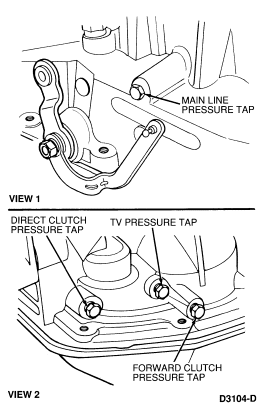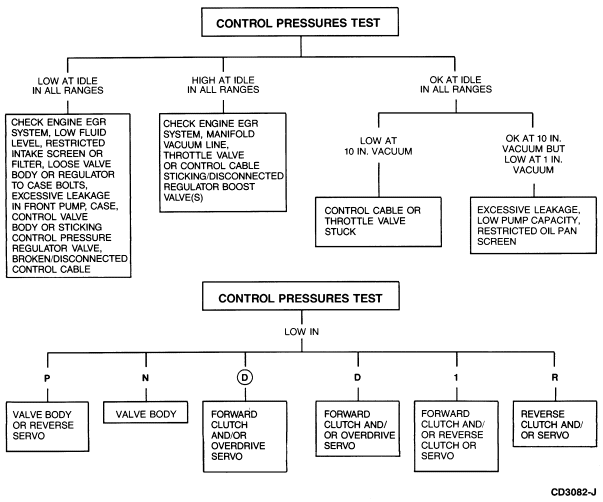After making the control pressure tests, analyze the results related to
the conditions in the following charts.
Keep in mind that clutch and servo leakage may or may not show
up on the control pressure test. This is because the pump has a high output
volume and the leak may not be severe enough to cause a pressure drop; and
orifices between the pump and pressure chamber may maintain pressure at the
source, even with a leak downstream. Pressure loss caused by a less than major
leak is more likely to show up at idle than at WOT where the pump is delivering
full volume.
Conversely, when manipulating the TV linkage to simulate WOT,
but actually testing at idle, the leak is more likely to cause a pressure loss
in the WOT position.
To further isolate leakage in a clutch or servo circuit, it is
necessary to remove the oil pan and valve body and to perform case air pressure
tests.
| Control Pressures Condition |
Possible Cause(s) |
| Low in P |
Valve body bolts loose, main oil regulator valve sticking, low reverse servo leakage. |
| Low in R |
Reverse clutch leakage, low reverse servo leakage. Valve body bolts loose. |
| Low in N |
Valve body bolts loose, main oil regulator valve sticking. |
| Low in (D) |
Forward clutch leakage, overdrive servo leakage, valve body bolts loose, main oil regulator valve sticking. |
| Low in D |
Forward clutch leakage, overdrive servo leakage, valve body bolts loose, main regulator valve sticking. |
| Low in 1 |
Forward clutch leakage. Low/reverse servo leakage. Overdrive servo leakage. |
| Low at idle in all ranges |
Low fluid level, restricted oil filter, loose valve body bolts, pump leakage, case leakage, valve body leakage, excessively low engine idle, fluid too hot, main oil regulator valve sticking. |
| High at idle in all ranges |
TV linkage, valve body (throttle valve or main oil regulator valve sticking) |
| OK at idle but low at WOT |
Internal leakage, pump leakage, restricted inlet screen, TV linkage, valve body (TV or TV limit valve sticking, main oil regulator valve sticking). |
 CAUTION: Pressure gauges affect the shift quality of the transmission. Care
should be taken not to accelerate or decelerate rapidly. Possible transmission
failure could result.
CAUTION: Pressure gauges affect the shift quality of the transmission. Care
should be taken not to accelerate or decelerate rapidly. Possible transmission
failure could result. 
